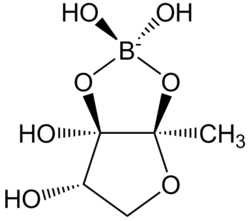Autoinducer-2
 | |
| Names | |
|---|---|
| IUPAC name
(3aS,6S,6aR)-2,2,6,6a-tetrahydroxy-3a-methyltetrahydrofuro[3,2-d][1,3,2]dioxaborolan-2-uide) | |
| Other names
Dihydroxy[(2S,3R,4S)-2-methyldihydro- | |
| Identifiers | |
| 3D model (Jmol) | Interactive image |
| ChEBI | CHEBI:40646 |
| ChemSpider | 393894 |
| PubChem | 446576 |
| |
| |
| Properties | |
| C5H10BO7 | |
| Molar mass | 192.940 |
| Except where otherwise noted, data are given for materials in their standard state (at 25 °C [77 °F], 100 kPa). | |
| | |
| Infobox references | |
Autoinducer-2 (AI-2), a furanosyl borate diester, is a member of a family of signaling molecules used in quorum sensing.[1] AI-2 is one of only a few known biomolecules incorporating boron. First identified in the marine bacterium Vibrio harveyi, AI-2 is produced and recognized by many Gram-negative and Gram-positive bacteria.[2][3] AI-2 arises by the reaction of 1-deoxy-3-dehydro-D-ribulose, which is produced enzymatically, with boric acid [4] and is recognized by the two-component sensor kinase LuxPQ in Vibrionaceae.
AI-2 is actively transported by the Lsr ABC-type transporter into the cell in Enterobacteriaceae and few other bacterial taxa (Pasteurella, Photorhabdus, Haemophilus, Bacillus),[5] where it is phosphorylated by LsrK . Then, Phospho-AI-2 binds the transcriptional repressor protein, LsrR, which subsequently is released from the promoter/operator region of the lsr operon – and transcription of the lsr genes is initiated. AI-2 signalling is also regulated by glucose and cAMP/CRP via the lsr operon. In the presence of glucose, low levels of cAMP/CRP result in almost no lsr operon (lsrABCDFG) expression. Without glucose, cAMP-CRP is needed to stimulate the lsr expression, while LsrR represses its expression in the absence of the inducer, phospho-AI-2. As AI-2 accumulates, more AI-2 is taken in via LsrABCD, phosphorylated via LsrK, and the lsr transcription is de-repressed, enabling even more AI-2 uptake.[6]
Doubts have been expressed regarding AI-2's status as a universal signal. Although the luxS gene, which encodes the protein responsible for AI-2 production is widespread, the latter has mainly a primary metabolic role in the recycling of S-adenosyl-L-methionine, with AI-2 being a by-product of that process.[7] An unequivocally AI-2 related behavior was found to be restricted primarily to organisms bearing known AI-2 receptor genes.[8] Thus, while it is certainly true that some bacteria respond to AI-2, it is doubtful that it is always being produced for purposes of signaling.
References
- ↑ Cao, Jie-Gang; Meighen, Edward A. (1989). "Purification and structural identification of an autoinducer for the luminescence system of Vibrio harveyi". Journal of Biological Chemistry. 264 (36): 21670–21676. PMID 2600086.
- ↑ Miller, Stephen T.; Xavier, Karina B.; Campagna, Shawn R.; Taga, Michiko E.; Semmelhack, Martin F.; Bassler, Bonnie L.; Hughson, Frederick M. (2004). "Salmonella typhimurium Recognizes a Chemically Distinct Form of the Bacterial Quorum-Sensing Signal AI-2". Molecular Cell. 15 (5): 677–687. doi:10.1016/j.molcel.2004.07.020. PMID 15350213.
- ↑ Miller, M. B.; Bassler, B. L. (2001). "Quorum sensing in bacteria". Annual Review of Microbiology. 55: 165–199. doi:10.1146/annurev.micro.55.1.165. PMID 11544353.
- ↑ http://www.chem.qmul.ac.uk/iubmb/enzyme/reaction/misc/AI2.html
- ↑ Rezzonico, F.; Smits, T.H.M.; Duffy, B. (2012). "Detection of AI-2 receptors in genomes of Enterobacteriaceae suggests a role of type-2 quorum sensing in closed ecosystems". Sensors. 12: 6645–6665. doi:10.3390/s120506645.
- ↑ Wang, Liang; Hashimoto, Yoshifumi; Tsao, Chen-Yu; Valdes, James J.; Bentley, William E. (2005). "Cyclic AMP (cAMP) and cAMP Receptor Protein Influence both Synthesis and Uptake of Extracellular Autoinducer 2 in Escherichia coli". Journal of Bacteriology. 187 (6): 2066–2076. doi:10.1128/JB.187.6.2066-2076.2005. PMC 1064054
 . PMID 15743955.
. PMID 15743955. - ↑ Diggle, S. P.; Gardner, A.; West, S. A.; Griffin, A. S. (2007). "Evolutionary theory of bacterial quorum sensing: when is a signal not a signal?". Philosophical Transactions of the Royal Society B: Biological Sciences. 362 (1483): 1241. doi:10.1098/rstb.2007.2049.
- ↑ Rezzonico, F.; Duffy, B. (2008). "Lack of genomic evidence of AI-2 receptors suggests a non-quorum sensing role for luxS in most bacteria". BMC Microbiology. 8: 154. doi:10.1186/1471-2180-8-154. PMID 18803868.